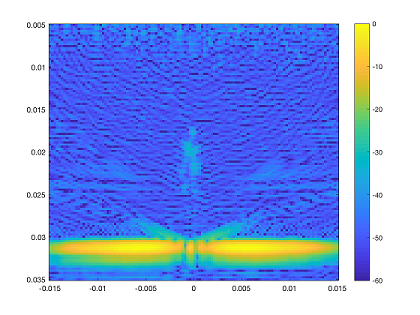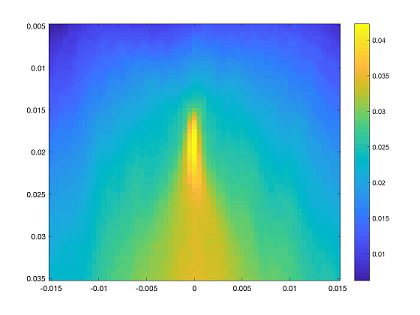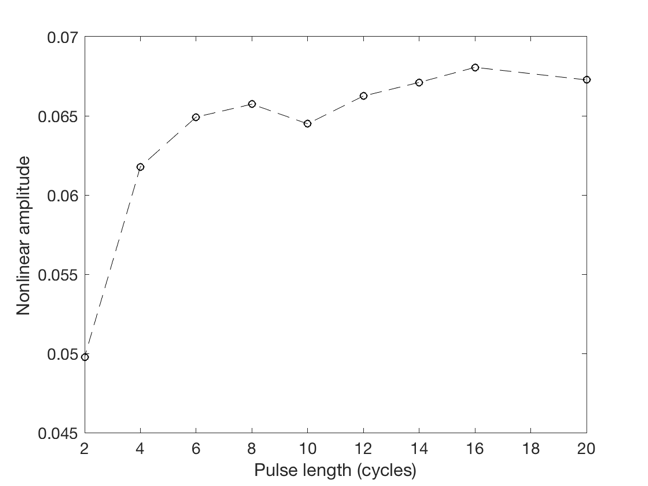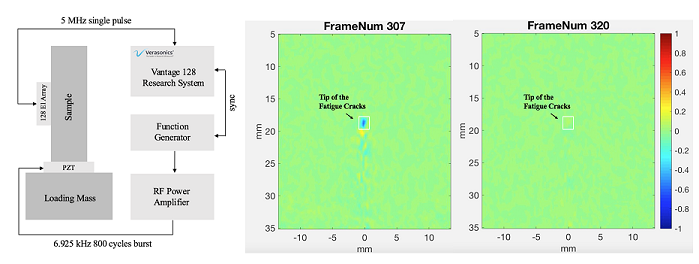Welcome to the third issue of Volume 3 of PLANE WAVE, Verasonics’ Newsletter through which we share information about new products and technologies, emerging applications, conferences, training opportunities, and collaborations with researchers in ultrasound and ultrasonic technologies. We hope you find these newsletters informative and interesting, and welcome your suggestions for future topics.
New Products and Applications ▪ Technology Information ▪ Research ▪ Conferences and Training
Cutting-Edge NDE Development on the Vantage System:
Nonlinear and Ultra-high Frame Rate Imaging
Increasingly, the Verasonics Vantage system is being recognized as a leading ultrasound research platform within the field of NDE. Here we examine two examples for which the features and performance of the Vantage platform provides both improvements to existing areas of research and the development of entirely new inspection techniques.
Nonlinear Diffuse Energy Imaging
Elastic nonlinearity is a modality of interest in NDE for its sensitivity to macroscopic defects, such as closed cracks, and also the micro-structural material changes associated with damage precursors. A recent research trend has been the development of methods utilizing phased arrays to allow imaging of elastic nonlinearity. Cutting edge developments in nonlinear imaging necessitate high performance hardware, placing Vantage as an ideal platform for such research.
The technique widely considered the current state of the art in nonlinear imaging is nonlinear diffuse energy imaging[1]. This method exploits differences between physical and synthetic beamforming to measure elastic nonlinearity. Crucially, rather than relying on scattering from defects, nonlinearity is instead inferred by evaluating differences in the later-time statistical diffuse energy of the two forms of focused field.
An example of nonlinear diffuse energy imaging running on a Vantage 128™ system is shown below in comparison to a linear TFM image acquired on the same hardware. These images are of a fatigue crack within an Aluminum block, captured using a 64-element 5 MHz array. The Vantage platform delivers excellent nonlinear imaging performance, providing both increased detectability and more accurate defect sizing over conventional linear imaging.

Linear TFM fatigue crack image (dB)

Nonlinear diffuse energy image
There are a number of properties of the Vantage platform that make it particularly suited to such nonlinear imaging, notably arbitrary waveform generation and the system’s inherent linearity.
Transmission Linearity
Ultimately, the sensitivity of many nonlinear imaging methods is limited by the linearity of instrumentation. Differences in instantaneous load can produce a systematic nonlinearity on transmission, that is a difference in the total energy outputted in full and sub-aperture (or synthetic aperture) transmissions.
The background value within diffuse energy images is equivalent to this system transmit nonlinearity. In this example it is seen that the Vantage system exhibits a systematic nonlinearity of approximately 0.5%. This transmit nonlinearity is well below the requirement for imaging of fatigue cracks and is comparable with that previously reported for other systems[2].
It should be noted that the example here of a single element sub-aperture demonstrates the upper limit of system nonlinearity. For methods using larger sub-apertures, such as the common checker boarding approach which using a half-array sub aperture, the transmit nonlinearity is even smaller.
Arbitrary Waveform Generation
Nonlinear methods require precise control of the transmitted spectra, since nonlinear elastic effects are determined by the waveform that physically exists within a medium. In this regard, the arbitrary waveform generation (AWG) capability provided by the Vantage system offers distinct advantages to nonlinear techniques over the more commonly employed broadband square wave excitation.
In this example, the advantage of AWG derives from the ability to control transmission bandwidth. This imaging metric quantifies the total nonlinear movement of energy away from the transmission bandwidth. If the bandwidth is too wide then energy flux can occur internally within the transmit band, for example super-harmonic generation from the lower end of the band can move to the upper end. This internal movement of energy not only doesn’t contribute to the image metric but actively reduces imaging sensitivity.
The figure below shows how the nonlinear sensitivity varies with transmission bandwidth for the previous fatigue crack sample. By providing the ability to control transmission bandwidth, the Vantage NDE research platform provides in the order of 50% improved nonlinear imaging sensitivity over square wave excitation.

Nonlinear Sensitivity Dependency on Transmission Bandwidth
Ultra-high Frame Rate or Ultrafast Imaging/Acquisition
The ultrafast (very high frame rate) imaging capability offered by the Vantage platform has enabled many major innovations in biomedical ultrasound research.A key advantage of ultrafast ultrasound imaging is the ability to provide effective temporal sampling of real-time dynamic processes, allowing fast motion tracking and analysis of dynamic systems, not possible using conventional imaging technologies.
Conventionally, phased array imaging in NDT examines static objects. Additional information useful for inspections may be gained from observing the dynamics of features inside. For example, analysis of the hysteresis, conditioning and slow dynamics of contact interfaces has led to the understanding of non-classical dynamic elastic nonlinearity. Leveraging the ultrafast imaging capability of Vantage systems, a recent joint research by Verasonics and Tohoku University aims to push the phased array technology towards that direction.
Presented in [3,4] is an example of ultrafast ultrasound imaging applied in NDT for closed crack characterization. Very high frame rate images were acquired to capture the fast dynamic of a fatigue crack in response to a 7 kHz pump wave. The figures below show two selected frames, where image intensity varies around the tip of the crack, considered due to the periodical fatigue crack opening and closing at 7 kHz. Looking at the intensity variation over time, hysteresis and slow dynamics are likely observed around the crack tip during and immediately after the external pump. Research is on-going to extract the phase information from the dynamic. Statistical analysis will be applied (to the highly temporal- and spatial- resolved ultrafast data) to gain new information.
It is expected that ultrafast imaging/acquisition will benefit other applications, where high-speed production line inspections, fast 3D imaging and weak signal detection, etc., are required.

[1] Potter et al. Nonlinear ultrasonic phased array imaging. Phys. Rev. Lett. 113, 144301 (2014).
[2] Potter. Characterization of Nonlinear Ultrasonic Diffuse Energy Imaging. IEEE Transactions on Ultrasonics, Ferroelectrics, and Frequency Control 65(5) 860-870 (2018).
[3,4] Yoshikazu Ohara, Sylvain Haupert and Sinan Li, Ultrafast phased array imaging: an application to closed crack characterization, 45th Annual Review of Progress in Quantitative Nondestructive Evaluation, Burlington, Vermont, 2018, 296.
Yoshikazu Ohara, Sylvain Haupert and Sinan Li, Ultrafast phased array imaging: an application to closed crack characterization, IEEE International Ultrasonics Symposium, Kobe, Japan, 2018, 5K-2.
Visit Us and Learn What’s New at these Upcoming Conferences:
Currently there are no upcoming conferences, however, please join us for our next Vantage customer training via live webinar, 1-4 February, 2021, 9 – 11 am PT.
Please contact [email protected] to register or click here for more information.

